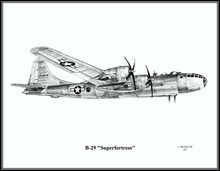 Loading... Please wait...
Loading... Please wait...- Home
- Combat Aircraft/Pencil Drawings ~ Free Shipping
- Boeing B-29 "Super Fortress" ~ Free Shipping
Product Description
Print Size 8½" x 11" ----- Unlimited print edition
The Boeing B-29 Superfortress was a four-engine heavy bomber propeller aircraft flown by the United States Military in World War II and Korea, and by other nations afterwards. The name "Superfortress" was derived from its well-known predecessor, the B-17 Flying Fortress. The B-29 Boeing Model 345 was one of the largest aircraft to see service during World War II. It was one of the most advanced bombers of its time, featuring innovations such as a pressurized cabin, a central fire-control system, and remote-controlled machine gun turrets. It was designed as a high-altitude daytime bomber, but flew more low-altitude nighttime incendiary bombing missions. It was the primary aircraft in the U.S. firebombing campaign against Japan in the final months of World War II, and B-29s carried the atomic bombs that destroyed Hiroshima and Nagasaki. Unlike many other bombers, the B-29 remained in service long after the war ended, a few being employed as flying television transmitters for Stratovision. By the time it was retired in the 1960s, some 3,900 aircraft had been built. The airframe was further developed into the B-50 for the USAF, and the Soviet Union developed a virtual carbon copy Tupolev Tu-4 which was reverse engineered from confiscated B-29 bombers.
Warranty Information
null








